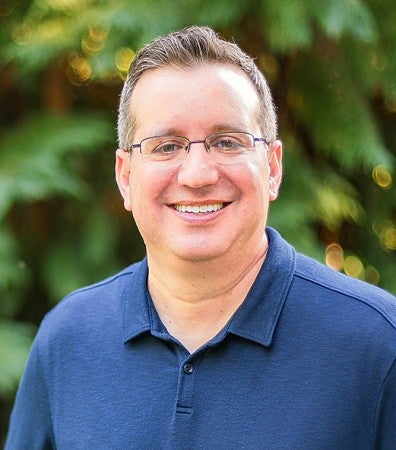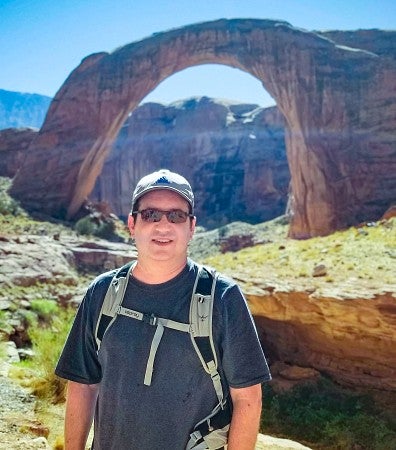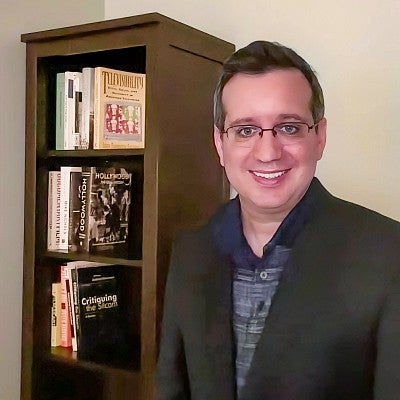
Daniel Zweifach
Assistant Professor of Advertising
Hometown: I grew up in San Diego and am excited to make Eugene my new home.
Hobbies: Traveling and hiking top the list. I’m aiming to visit all 50 states — I only have one left — and all national parks. As a cinema and media studies Ph.D., I also love watching movies.
Favorite books and authors: In an academic sense, I would say Raymond Williams. His writing on advertising and culture was my first introduction to academic analysis of advertising during my freshman year of college, and I still teach about his work today. In my free time, I enjoy mysteries and am fond of Agatha Christie.
Favorite quote: “Education is the most powerful weapon which you can use to change the world.” —Nelson Mandela
Favorite artist: My favorite artist would have to be Bruce Springsteen.
Daniel Zweifach, assistant professor of advertising, grew up in San Diego but is looking forward to finding a community within Eugene and the SOJC. He is passionate about traveling and has almost completed his goal of visiting every state and national park in the United States. Zweifach is a cinema scholar and enthusiast, and he earned his Ph.D. in film and television. His passion is apparent in his thesis “Social Media Marquee,” which examines the interaction between Hollywood, marketing and social media.
A scholar with industry experience and a résumé that includes Google, Zweifach brings a unique blend of professional and academic expertise to his SOJC classes. As a teacher, he views himself as a bridge between the industry and the classroom. His teaching focuses on collaboration and emphasizes the dynamic between learning and being in a field that is rapidly evolving.
Zweifach, in his own words, delved further into his career and projects.
Your dissertation “Social Media Marquee” focuses on the interaction between social media, traditional media and entertainment. How did you develop an interest in that relationship?
Daniel Zweifach: Before entering academia, I led marketing and advertising teams at Google. I was always fascinated by the intersection — and increasing overlap — between Silicon Valley and Hollywood. This interest grew during my media studies Ph.D. at UCLA. Traditional media remains important, but its influence is mediated by digital and social media. For example, many more people may watch a movie’s YouTube trailer — or a TikTok post about it — than actually watch the full movie. To understand today’s traditional media, we must investigate its digital context.

Do you primarily focus on text, image or video in your research?
DZ: My research focuses especially on digital advertising, so text, video and image all matter — as does understanding the algorithms that underpin today’s advertising platforms.
Who has been the biggest influence on your career?
DZ: At UCLA, I was blessed with wonderful mentors, including Denise Mann, my dissertation chair, and John Caldwell. But I also have to credit my family. My late mom, Jane Amsler, instilled in me intellectual curiosity and the value of ongoing education.
Why did you decide to join the SOJC faculty?
DZ: The University of Oregon’s interdisciplinary approach among the SOJC’s different areas, including media studies and advertising, is a significant draw for me. This environment fosters collaboration and allows for a holistic understanding of the evolving media landscape, which I believe is essential for preparing students to excel in their future careers. Additionally, the university’s commitment to climate communication and justice, along with initiatives like the SOJC Diverse Alumni Mentoring Network, aligns with my professional values. I am keen to support these efforts by linking students with alumni resources and nurturing a learning space where diverse viewpoints are celebrated and harnessed for innovation.
What do you hope to accomplish at the SOJC?
DZ: I aim to bridge my industry experience with academic research to provide students with a comprehensive understanding of modern advertising. I hope to contribute to the development of cutting-edge advertising strategies that emphasize diversity and inclusivity.
What do you hope students will gain from your classes?
DZ: I want my students to gain a thorough understanding of digital advertising’s complexities and its societal impacts. They should leave my classes equipped with both theoretical knowledge and practical skills, ready to innovate in the ever-evolving advertising landscape.
Can you tell me more about your recent projects?
DZ: My dissertation, “Social Media Marquee,” explores the intersection of Hollywood and social media marketing. I aim to highlight the cultural implications of this relationship and its impact on diversity and representation in media. Another project, the Digital Incubator and Think Tank at UCLA, distills cutting-edge academic research so it’s relevant to today’s advertisers, marketers and business owners.

What are three things you want every student to know about you?
DZ: 1. Ask me if I’ve reached my goal of visiting all 50 states!
2. I bring both my professional background at Google and my academic advertising research to the classroom.
3. I view teaching as a collaboration. When we explore social media or AI, we’re learning together.
What is your favorite advertisement? Do you have a least favorite?
Favorite: As an advertising and movie scholar, I have to go with Roger Kastel’s iconic poster for Jaws (1975).
I don’t have a specific least favorite, but I’d say any misleading ad, especially online. I believe advertising can and should be truthful and relevant.
—By Ethan Donahue, class of ’26
Ethan Donahue is a journalism major with a double major in history. He is part of the School of Journalism and Communication’s direct-admit and honors programs. He is also part of the Clark Honors College. He holds an interest in investigative and conflict journalism and is working on a thesis focusing on how journalism, propaganda and the U.S. government interact during conflicts.
